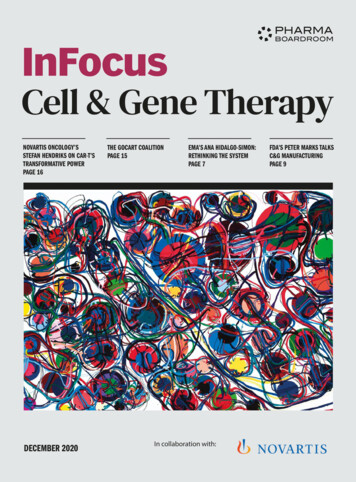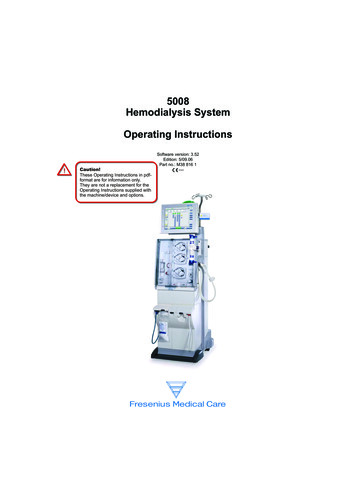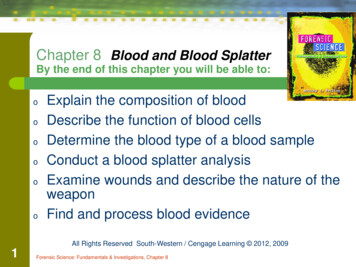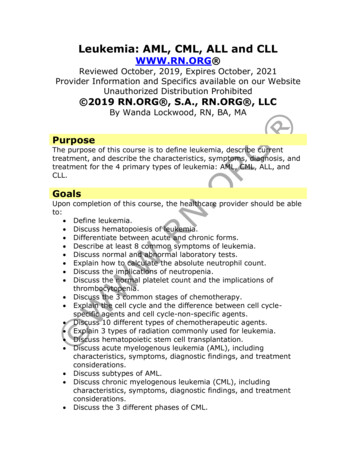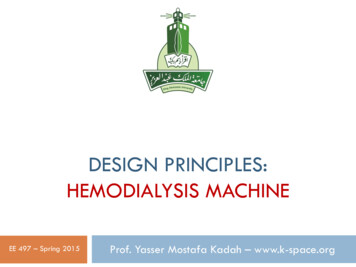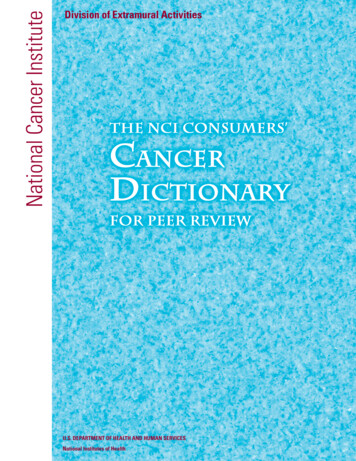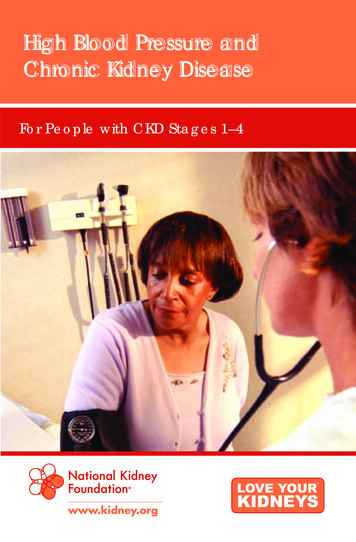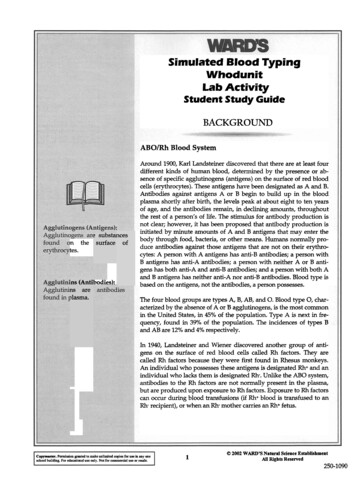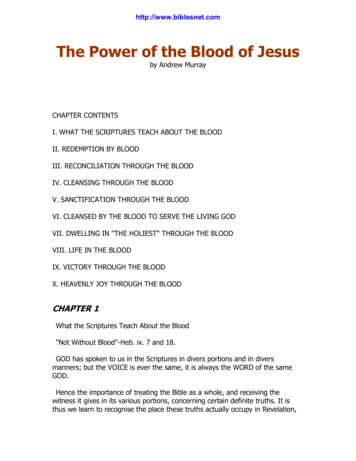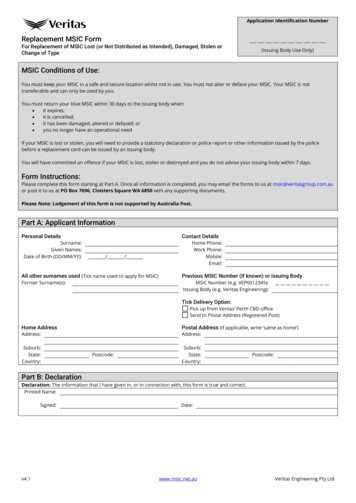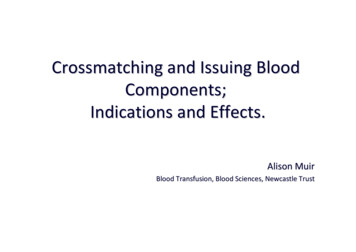
Transcription
Crossmatching and Issuing BloodComponents;Indications and Effects.Alison MuirBlood Transfusion, Blood Sciences, Newcastle Trust
Topics Covered Taking the blood sampleABO GroupAntibody ScreeningCompatibility testingRed cellsPlateletsFresh Frozen Plasma (FFP)CryoprecipitateOther Products
Taking the Blood SpecimenPositively identify the patientAsk the patient to state their nameand date of birthInpatients - Look at the wristbandfor the Hospital Number and toconfirm the name and date ofbirth are correctOutpatients – Take the hospitalnumber from the notes or otherdocumentation having confirmedthe name and d.o.b.
Take the blood specimenLabel the tube AT THEBEDSIDE. the label must behand-writtenThe specimen bottle shouldbe labelled with:First NameSurnameHospital numberDate of BirthEnsure the Declaration is signed on the request formTaking blood from thewrong patient can leadto a fatal transfusionreaction
Request Form
Transfusion Sample Timings?Patients who have recently been transfused may formred cell antibodies. A new sample is required at thefollowing times before any transfusion when:Patient Transfused orPregnant within thepreceding 3 months:Sample required within72 hours beforetransfusionUncertain or informationunavailable of transfusion orpregnancy:Sample required within72 hours beforetransfusionPatient NOT transfused orpregnant within thepreceding 3 months:Sample valid for 3months
ABO Group Testing Single most important serological testperformed on pre transfusion samples.Guidelines for pre –transfusioncompatibility procedures Sensitivity and security of testing systemsmust not be compromised.
Antibody Screening Antibody screening - the most reliable and sensitivemethod for the detection of red cell antibodies. Donor units less reliable because the expression of bloodgroup antigen varies according to genotype. Antibody screen in advance to provide blood fortransfusion. Alerts the clinician to possible delays. Allows lab to identify antibodies and select suitable units.
Compatibility Testing To exclude incompatibility between donor andrecipient IAT serological compatibility test Electronic issueThe specification and use of informationtechnology systems in blood transfusionpractise (BCSH,2014)
Selection of Groups ABO / RhD group selected whenever possible. Group O red cells can be given to other blood groups. Group AB patients should receive red cells from group ABthen A or B rather than group O. RhD Positive cellular products (Red Cells and Platelets) shouldnot be given to RhD Negative females who are under 50 yrsold (45-60). Group O plasma should only be given to group O patients Group A and AB plasma can be given to other blood groups
Red Blood CellsPurpose: To restore oxygen carryingcapacity in patients with anaemia orblood loss.Average volume:220 - 340 mLStorage temp:2 to 6oCExpiry:35 daysMUST BeCompatiblewith ABO ofrecipient(14 days if irradiated)Extra info:HCT 0.5 - 0.7L/LHb 40g
Who can have what Red Cells?
Administration A dose of 1 unit will Hb concentration byapproximately 10g/L. Many patients can be safely transfused over 90-120minutes per unit. However, transfusions must becompleted within 4 hours of removal fromcontrolled temperature storage. During Major Haemorrhage, very rapid transfusionmay be required (each unit 5-10 mins)Risks: Febrile Non-Hemolytic transfusion reaction, allergic reactions, transfusion associated circulatoryoverload (TACO), transfusion related acute lung injury (TRALI), bacterial contamination, hemolyticreactions, alloimmunization, anaphylaxis, graft vs. host disease, hyperkalemia, iron overload, posttransfusion purpura and transmission of infection.
PlateletsPurpose: Platelet transfusion is indicated forthe treatment or prevention ofbleeding in patients with a lowplatelet count or dysfunction.Preferably ABOof recipient.Group Auniversal.Give group O togroup O.Average volume:Storage temp:Expiry:Up to 300 mL20 to 24oC7 daysExtra info: ABO antigens on surface and may havereduced survival if transfused to an ABOincompatible recipient, although this isnot usually clinically significant.
Administration A dose of 1 pooled unit would typically containbetween 2.5-3 x1011/L and should raise the plateletcount by 20-40 x 109/L. Transfused through a giving set not used for othercomponents usually over 30-60 mins. Survival oftransfused platelets lasts around 3-5 days.Indications for use: With haemorrhage: a. Aim for a platelet count of 75 x 109/lb. In multiple trauma, eye or Central Nervous System (CNS) injury keep the platelet count 100 x 109/l Prophylaxis:a. Platelet count 10 x 109/L (except in stable patients with long term bone marrowfailure)b. Platelet count 20 x 109/L in the presence of additional risk factors for bleeding (e.g. sepsis) Pre-procedurea. Platelet count 50 x 109/L prior to an invasive procedure (e.g. laparotomy) notindicated prior to bone marrow aspiration or biopsyb. Platelet count 100 x 10 9 /L prior to a procedure involving the CNS or eye.
Fresh Frozen PlasmaPurpose: Treatment of patients with bleedingdue to multiple clotting deficienciessuch as DIC, Major Haemorrhage.Average volume:150 - 300 mLsStorage temp:Below -25ºCPreferably ABO Expiry:Frozen - 3 yearsof recipient.Thawed:24 hours (at 4oC)Group A4 hours (Room Temp/unknown)universal.Give group O to Extra info: No longer indicated for warfaringroup O.reversal.
Administration Dose typically 12-15 mL/kg, depending on clinicalindication, pre & post transfusion coagulation tests &clinical response. Infusion rate typically 10-20 mL/kg/hour, more rapidtransfusion when treating coagulopathy in majorhaemorrhage (Note: patients receiving FFP must havecareful haemodynamic monitoring to prevent TACO)Indications for use: Replacement of single inherited coagulation factor deficiencies where a specific or combined factorconcentrate is unavailable eg factor V Acute Disseminated Intravascular Coagulation (DIC) in the presence of bleeding and abnormal coagulationresults Thrombotic Thrombocytopenic Purpura (TTP), usually use Solvent Detergent FFP Replacement of coagulation factors due to major haemorrhage. FFP should NEVER be used simply as circulating volume replacement.
CryoprecipitateGroup Auniversal.Limited grouptype supplied.Purpose: Rich in fibrinogen, Factor VIIIand Von Willibrand factor. Usedas a more concentration sourceof fibrinogen.Average volume (pool): 100 - 250 mL(single): Approx. 50 mLStorage temp: below -25ºCExpiry:Frozen - 3 yearsThawed:4 hrs (Room Temp)Extra info: Typical adult dose 2 pools
Administration A dose of two pools would typically contain between 33.5g of fibrinogen and raise the plasma fibrinogen levelby about 1g/L. Transfuse using a standard blood giving set over 30 –60min per pool within 4 hours of defrosting.Indication for use: Acute Disseminated Intravascular Coagulation (DIC) where there is bleeding and a fibrinogen level 1g/L Advanced liver disease when the fibrinogen level is 1g/L Bleeding associated with thrombolytic therapy causing hypofibrinogenaemia Hypofibrinogenaemia secondary to massive transfusion a fibrinogen level of 1.5g/L is required Renal failure or liver failure associated with abnormal bleeding when Desmopressincontraindicated/ineffective Inherited hypofibrinogenaemia where fibrinogen concentrate is not available.
Other Products Irradiated – Graft versus Host DiseaseWashed – IgA deficient with anti-IgA, ABOi CTxCMV negative – assymptomatic/severe infectionHep E Virus Negative - ? Implemented this yearHLA matched platelets / Red Blood Cells in specific patients dueto alloimmunisation. Granulocytes Plasma derivatives: Factor VIII ConcentrateFactor IX ConcentrateAlbuminIVIgAnti-D prophylaxis
Pre-procedure a. Platelet count 50 x 10 9/L prior to an invasive procedure (e.g. laparotomy) not indicated prior to bone marrow aspiration or biopsy b. Platelet count 100 x 10 9 /L prior to a procedure involving the CNS or eye.
